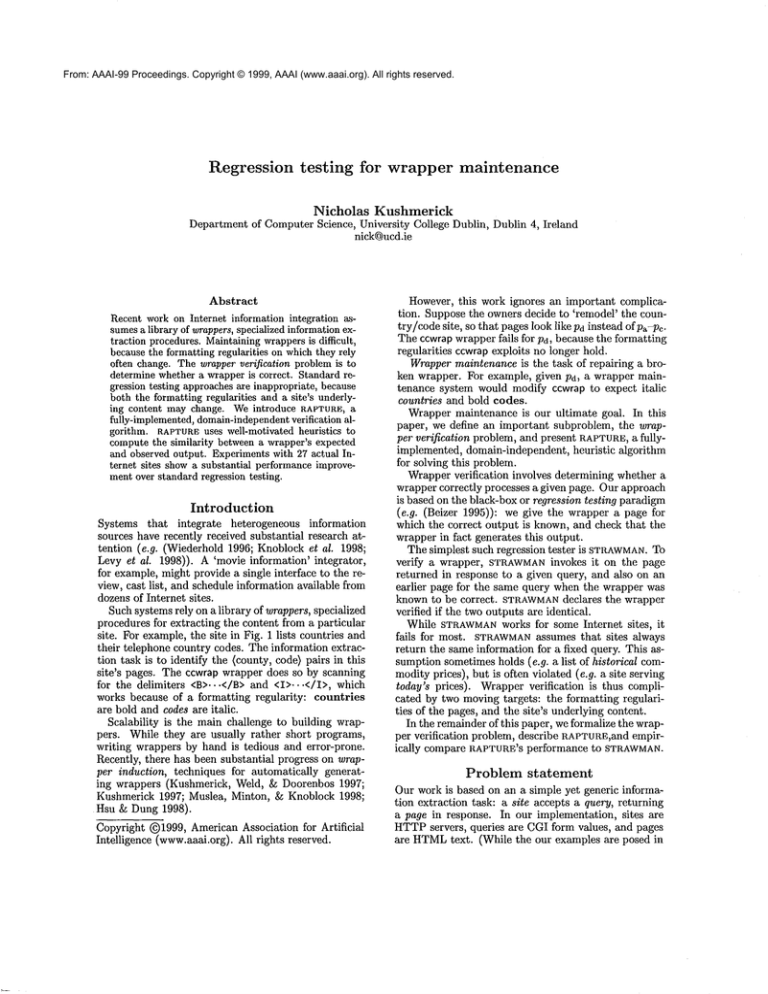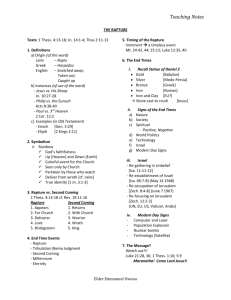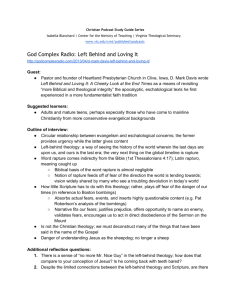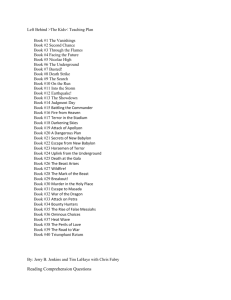
From: AAAI-99 Proceedings. Copyright © 1999, AAAI (www.aaai.org). All rights reserved.
Regression
testing
for
Nicholas
wrapper
maintenance
Kushmerick
Department of Computer Science, University College Dublin, Dublin 4, Ireland
nick@ucd.ie
Abstract
Recent work on Internet information integration ~sumesa library of wrappers,specialized informationextraction procedures. Maintainingwrappersis difficult,
because the formatting regularities on whichthey rely
often change. The wrapper verification problem is to
determine whether a wrapper is correct. Standard regression testing approachesare inappropriate, because
both the formatting regularities and a site’s underlying content may change. Weintroduce RAPTURE,
a
fully-implemented, domain-independentverification algorithm. RAPTURE
uses well-motivated heuristics to
computethe similarity between a wrapper’s expected
and observed output. Experiments with 27 actual Internet sites showa substantial performance improvement over standard regression testing.
Introduction
Systems that integrate
heterogeneous information
sources have recently received substantial research attention (e.g. (Wiederhold 1996; Knoblock et al. 1998;
Levy et al. 1998)). A ’movie information’ integrator,
for example, might provide a single interface to the review, cast list, and schedule information available from
dozens of Internet sites.
Suchsystems rely on a library of wrappers, specialized
procedures for extracting the content from a particular
site. For example, the site in Fig. 1 lists countries and
their telephone country codes. The information extraction task is to identify the (county, code) pairs in this
site’s pages. The ccwrap wrapper does so by scanning
for the delimiters <B>...</B> and <I>...</I>, which
works because of a formatting regularity:
countries
are bold and codes are italic.
Scalability is the main challenge to building wrappers. While they are usually rather short programs,
writing wrappers by hand is tedious and error-prone.
Recently, there has been substantial progress on wrapper induction, techniques for automatically generating wrappers (Kushmerick, Weld, & Doorenbos 1997;
Kushmerick 1997; Muslea, Minton, & Knoblock 1998;
Hsu & Dung 1998).
Copyright (~)1999, American Association for Artificial
Intelligence (www.aaai.org). All rights reserved.
However, this work ignores an important complication. Suppose the owners decide to ’remodel’ the country/code site, so that pages look like Pd instead ofpa-Pc.
The cewrap wrapper fails for Pd, because the formatting
regularities ccwrapexploits no longer hold.
Wrapper maintenance is the task of repairing a broken wrapper. For example, given Pd, a wrapper maintenance system would modify ccwrap to expect italic
countries and bold codes.
Wrapper maintenance is our ultimate goal. In this
paper, we define an important subproblem, the wrapper verification problem, and present RAPTURE,
a fullyimplemented, domain-independent, heuristic algorithm
for solving this problem.
Wrapper verification involves determining whether a
wrapper correctly processes a given page. Our approach
is based on the black-box or regression testing paradigm
(e.g. (Beizer 1995)): we give the wrapper a page
which the correct output is known, and check that the
wrapper in fact generates this output.
The simplest such regression tester is STRAWMAN.
To
verify a wrapper, STRAWMAN
invokes it on the page
returned in response to a given query, and also on an
earlier page for the same query when the wrapper was
known to be correct. STRAWMAN
declares the wrapper
verified if the two outputs are identical.
While STRAWMAN
works for some Internet sites, it
fails for most. STRAWMAN
assumes that sites always
return the same information for a fixed query. This assumption sometimes holds (e.g. a list of historical commodity prices), but is often violated (e.g. a site serving
today’s prices). Wrapper verification is thus complicated by two moving targets: the formatting regularities of the pages, and the site’s underlying content.
In the remainder of this paper, we formalize the wrapper verification problem, describe RAPTURE,and
empirically compare RAPTURE’S performance to STRAWMAN.
Problem statement
Our work is based on an a simple yet generic information extraction task: a site accepts a query, returning
a page in response. In our implementation, sites are
HTTPservers, queries are CGI form values, and pages
are HTMLtext. (While the our examples are posed in
Pb
Pa
Pd
Pc
pa’s HTML
source (Pb’S andpc’s are similar):
~HTML><BODY>
~B>Argentina</B>,
<I>54</I><BR>
~B>Bangladesh</B>,
<I>880</I><BR>
~B>Croatia</B>,
<I>385</I><BR>
~B>Denmark</B>,
<I>45</I><BR>
~HR><I>Stop</I></BODY></HTML>
pd’S HTMLsource:
~HTML><BODY>
~I>Kenya</I>,
<B>254</B><BR>
~I>Libya</I>,
<B>218</B><BR>
~I>Mexlco</I>,
<B>52</B><BR>
~HR><I>Stop</I></BODY></HTML>
Figure 1: An example Internet site listing
countries and their telephone country codes, and the ccwrapwrapper.
terms of HTML,this is for simplicity only. Our techniques do not assume that pages are HTML.)
A wrapper is an information extraction procedure
tailored to a particular site. A wrapper takes as input a page, and outputs a label, a representation of the
page’s content. We assume a standard relational data
model: a page’s label is a set of tuples, each a vector
of K attributes. For example, K = 2 for page pa, and
its label is ga = {<Argentina, 54), <Bangladesh, 880),
<Croatia, 385),<Denmark,
45)}.
For wrapper w and page p, we write w(p) = £ to
indicate that w returns label g when invoked on p.
As we are concerned with cases in which a wrapper’s output is wrong, we say that a w is correct for p iff p’s label is in fact w(p). Thus,
ccwrap is incorrect for Pd, because ccwrap(pd)
{(254, Libya), <218, Mexico), (52, Stop)} instead
{(Hong Kong, 254), <Libya, 218), <Mexico, 52)}.
Wrapper verification is the problem of determining
whether a wrapper is correct. We assume access to
a collection of previously verified pages for which the
wrapper is known to be correct. Wealso assume that
we knowthe query used to generate each verified page.
The wrapper verification problem is the following.
The input is a wrapper w, page p, query q, sequence L =
{el,.-.
,~M} of labels, and sequence Q = {ql,...
,qM}
of queries. The output should be TRUEif w is correct
for p and FALSEotherwise.
The intent is that page p was retrieved using query q,
L contains the verified labels, and the page to whichlabel gi 6 L corresponds was retrieved with qi E Q. While
queries can be structured objects, RAPTURE
treats them
"atomically", only checking whether two queries are
equal.
The
RAPTURE algorithm
domain-independent,
heuristic
algoraithm for solving the wrapper verification problem.
RAPTURE
compares the verified labels with the label
output by the wrapper being verified.
Specifically, RAPTURE
compares the value of various
numeric features of the strings comprising the label output by the wrapper. For example, the word count feature is 2 for Great Britain, and 1 for Iraq. RAPTURE
RAPTURE
is
a
The ccwrap wrapper is correct forpa, pb
and Pc, but incorrect forPd:
irocedure ccwrap:
while there are more occurrences of ’<B>
skip to next ’<B>’
extract country through next ’</B>’
skip to next ’<I>’
extract code through next ’</I >’
return all extracted (country,code) pairs
computes the values of such features for each extracted
]attribute.
These values are compared with those for the verified label attributes. The mean feature values are calculated, and then the probabilities that each extracted
attribute’s feature values agree with these values are
calculated. Each such probability captures the strength
of the evidence provided by a particular feature that
a specific attribute was correctly extracted. Finally,
the individual probabilities are combined, producing an
overall probability that the wrapper is correct for the
page.
We use upper-case letters (e.g. R) for random variables and lower-case (e.g. r) for values of such variables. #n is R’s mean, and an is R’s standard deviation. Let R be normally distributed with parameters #R and an; P[r; #n; an] is the probability that R
equals r, and P[<r;#n; an] is the probability that R
does not exceed r. These probabilities are taken to be
the probability and cumulative density functions of the
]
_ l (.L~_B. ~2
normal distribution:
P[r; #n; an] - ~d~e 2, ~1~ ,
and P[<r; #n; an] = f~P[r’; #n; an]dr’.
Example
We begin by demonstrating
RAPTUREon the country/code example. Suppose ccwrap has been verified
for pages Pa and Pb, and we want to verify ccwrap for
pages Pc and Pd. Since ccwrap is in fact correct for Pc,
RAPWVRE(pc, CCwrap, {~a,~b})
should return TRUE;in
contrast, RAPTURE(pd,CCwrap,{L~a,L~b})
should return
FALSE. (We temporarily ignore the q and Q inputs to
RAPTURE;
we extend the algorithm below.)
Step 1: Number-of-tuple
distribution
parameters. RAPTURE
assumes that the number of tuples in
a label is described by the normally distributed random variable N. RAPTURE
computes the distribution
parameters #N and aN by treating the number of tuples n in Pa and Pb as samples of N (column 2 will be
1A wrapper’s execution can be undefined. For example,
ccwrapfails if it sees a <B>with no subsequent</B>,<I> or
</T>. For simplicity, wedo not discuss this scenario further,
though our implementations of STRAWMAN
and RAPTURE
immediatelyreject failed wrappers.
explained in Step 5):
n
pa 4
Pb
P[n; #N;aN]
0.44
I
3
/~N=3.5
aN=0.71
0.44
I
Step 2" Feature value distribution
parameters.
RAPTURE
examines the text fragments extracted from
pa and Pb, and computesthe values of a set of features.
These values are assumed to be normally distributed
for each feature/attribute
combination.
In this example, we consider two features:
word
count, and mean word length.
For example, E1
Salvador has 2 words and mean word length 6. RAPTUREreasons about a unique random variable for each
feature/attribute
combination: C1 is the word count of
the first attribute (country), C2 is the word count
the second attribute (code), U1 is the country’s mean
word length, and U2 is the code’s mean word length.
RAPTURE
uses Pa and Pb to estimate the 8 distribution parameters. For example, #c1 = 1.1 indicates
that country namesusually contain a single word, while
au= = 0.52 indicates that the mean word length of codes
have relatively low variance (columns 3 and 5 will be
explained in Step 5):
country
c P[c;lzc,;acl] u P[u;#u,;au,]
0.12
Argentina 1
0.98
9
pa Bangladesh 1
0.98
10
0.057
China
1
0.98
5
0.12
Denmark 1
0.98
7
0.22
E1 Salvadoz2
0.081
6
0.19
0.98
6
0.19
Pb France 1
Greece 1
0.98
6
0.19
pc,=1.1
#u, =7.0
cru, =1.8
ac,=0.38
code c
54
880
385
32
503
33
30
uPb;.u
; u1054
1
1.0
2
0.54
pa
1
1.0
3
0.42
1
1.0
3
0.42
2
0.54
1
1.0
0.42
1
1.0
3
2
0.54
pb
1
1.0
1
1.0
2
0.54
#u2= .4
#c2= .0
au2=0.53
ac2=0.0
Step 3: Feature probabilities.
RAPTUREuses
the distribution parameters from Steps 1-2 to compare
ccwrap’s labels for Pa and Pb, with those for Pc and Pd.
Recall that ccwrapis correct for Pc but incorrect for Pd.
RAPTURE
begins by examining the number of tuples
extracted by ccwrap: n = 3 for both pages. In Step
1, we estimated N’s distribution parameters ]~N = 3.5
and aN = 0.71. We can thus compute the probability
of the observed number of tuples n for each page:
n P[n;#N;aN]
pc 3
0.44
pd 3
0.44
RAPTURE
then computes the feature values for the
extracted fragments. Using the distribution parameters from Step 2, we compute the probability of each
observed feature value. In the example, we compute
12 probabilities each for Pc and Pd: 1 per feature, for
each of the 3 extracted fragments, for each of the 2 attributes. For example, P[2; ~1; O’c1] ~ 0.081 indicates
that a country name is somewhat unlikely to contain 2
words, while P[4; #u2; au2] = 9.9 x 10-4 indicates that
the mean word length of a code is rarely, 4.
country e P[c;#c,;acl] u Ptu;#vl;aul]
0.081
4
0.057
Hang Kong 2
pc Ireland
1
0.98
7
0.22
Japan 1
0.98
5
0.12
254
1
0.98
3
0.020
pd
218
1
0.98
3
0.020
-3
5.1x10
52
1
2
0.98
code c P[c;#c2;ac2]
u P[u;l~u2;av2]
852
1
1.0
3
0.42
pc
353
1
1.0
3
0.42
81
1
1.0
2
0.54
-~
7.0xlO
Libya 1
1.0
5
-I°
1.5x10
1.0
6
Pd Mexico 1
-4
9.9xi0
Stop 1
1.0
4
Step 4: Verification
probability.
Each probability in Step 3 represents the evidence from one feature
that a particular text fragment is correct. RAPTURE
now combines this evidence conjunctively, deriving an
overall verification probability that ccwrap is correct.
RAPTURE
assumes independence, and derives the verification probability by multiplying the conjuncts’ probabilities. (Our experiments consider other assumptions.)
The following table shows the verification probability v
for each page (column 3 will be explained in Step 5):
probabilities from Step 3
v
P[<v; #v; av]
pc -~
.44, .081, .98, .98, .057, .22, 4.9x10
0.26
.12, 1, 1, 1, .42, .42, .54
0.18
.44,.98,.98,.98,.020,.020,3.8x10
Pd -z~
-6,
5.1x10-3,1,1, 1,7.0x10
-4
1.5x10-l°, 9.9x10
Note that Pd has a low v because the mean word length
of the countries is so small, and so large for the codes.
Step 5: Evaluating verification
probability.
As
expected, ccwrap is muchmore likely to be correct for
Pa than for Pd. To complete our analysis, we could
simply compare such probabilities to a fixed threshold.
However, since we assumed independence and normality, the calculated verification probabilities maydeviate
greatly from their ’true’ values.
To address this problem, we treat each verification
probability v as a sample of a normal random variable
V. To calculate #y and ag, we repeat Step 4 for p~
and Pb:
probabilities from Steps 1-2
v
-°
3.8x10
pa .44, .98, .98, .98, .98, .12, .057, .12, .22, 1,
1, 1, 1, .54, .42, .42, .54
-b
Pb .44, .081, .98, .98, .19, .19, .19, 1, 1, 1: 2.9x10
.42, .54, .54
-°
/zv = 1.6x10
av -5
= 1.8x10
At this point, RAPTURE
can compare the verification
probabilities with those of pc or Pd- The simplest approach is to return FALSEif v < #V. However, we would
function RAPTURE(Wrapper w, page p, label set L)
if LABELPR(w(p),
L) <~ T return FALSE
else return
function LABELPR(label
g, label set L)
(#V,aV) +’- VERIFPRPARAMS(L)
return P[_<VERIFPR(g,
L); #v; av]
function VERIFPRPARAMS(label
set L)
probs ~- {VERIFPR(g,L)I tEL}
compute #v and av from probs
return (#v , av
function VERIFPR(label
g, label set L)
} ~ FEAPARAMS(L)
(#,,aN), {..-,(#F,.~,aF,.~)
q ~ P[IgI;#N;aN]
probs~- {q} [a]
~
for each feature fi E 9
for each attribute 1 < k < K
for each tuple (..., sk,...) E
q ~- e[f~(s~);~F,
~;aF,
probs <-- probsU~q}"
return .A(probs)[b]
function FEAPARAMS(label
set L)
values +- {IglleeL} [c]
compute #N and aN from values
rfor each feature fi E 5
for each attribute 1 < k < K
values +-- {fi(s) [ s in columnk of a label in
compute#F,k and aF~.k from values
return (#N,a~V),{..., (#Fi.k,/rVl.k) ....
Figure 2: The RAPTURE
algorithm.
like to be able to adjust RAPTURE’S
’pessimism’, making it more or less likely to declare a wrapper correct.
Wethus use the cumulative normal density function to
evaluate v. Specifically, the third columnin Step 4 lists
the probabilities that V < v, for Pc and Pd. RAPTURE
then compares this probability to a threshold r. For
example, if v = ¼, RAPTURE
returns TRUEfor Pc and
FALSEfor Pd. Note that T = ½ corresponds to the simpie approach of returning FALSEif V < #V.
Details
With the ideas underlying RAPTURE
now in place, we
list the RAPTURE
algorithm in detail; see Fig. 2. The
main subroutine is VERIFPR,which computes a label’s
verification probability v.
RAPTURE
refers to three parameters: a threshold ~against which verification probabilities are compared;a
feature set 9v, where each feature is function from a
string to a number; and a dependency assumption
,4, a function from a set of numbers to a number.
Feature
set ~"
RAPTUREis parameterized
by a feature set ~ =
{..., fi,-..}. Each feature f/is a function from a string
to a number. Ideally, features can be rapidly computed
(so RAPTURE
runs quickly) and are not domain specific
(so RAPTURE
can be applied without modification to
newsites).
Weused the following nine features in our experiments (numbers in parentheses are values for the string
’20 biaple St.’): digit density: fraction of numeric
characters (~52 -_ 0.167); letter density, fraction
letters (~ ----0.583); upper-case density, fraction
upper-case letters (~ = 0.167); lower-case density
(1~ = 0.417); punctuation density, (~ ---- 0.083);
HTMLdensity, fraction of < and > characters(~-°
0); length (12); word count (3); and mean
length
(~ =3).
Dependency
assumption
~4
Abstractly, RAPTURE
reasons about E events e~, ...,
eE. e27 might represent the event ’the number of words
in the third extracted country is consistent with the
countries extracted from the verified pages’. The algorithm has derived P[el], ..., P[eE], and must compute the probability that all feature values are consistent with the verified labels, P[A/ei]. RAPTURE
uses the
dependency assumption .4 to compute this probability;
see Step 4 above and line [b] in Fig. 2.
Computing P[Aie/] exactly requires knowledge of the
dependencies between the ei. In principle, this information could be derived for our domain, resulting in
a set of conditional probabilities for exactly calculating P[A~ei] = P[el]F[e2lel]...F[eEleE-1,...,el].
But
as this analysis would be extremely cumbersome, we
instead simply make assumptions about the dependencies of the domain. While the resulting probability can
be inaccurate, our experiments demonstrate that these
assumptions yield reasonable performance.
Wehave investigated three specific assumptions:
the independence, entailment, and equivalence assumptions. Each corresponds to a particular function for
computing P[Aiei] from P[el], ..., P[e~].
Independence assumption: If the ei are independent, then P[Aie~] ---- YIi P[e~].
Entailment assumption: If there exists an 1 < I <
E such that e1 logically entails every other ei, then
P[Aiei] = mini P[el]. The entailment assumption
presumes that one piece of evidence (e.g., perhaps the
number of extraced tuples) completely determines the
rest.
Equivalence assumption: H the ei are all logically
equivalent,
then P[A~e~] : e[el] ....
= P[eE].
Under the equivalence assumption, any piece of evidence is as reliable as any other. This assumption can
not be invoked directly, because the P[ei] are often unequal. RAPTURE
treats the P[ei] as noisy samples of the
’true’ value, which is estimated as the sample’s geometric mean: P[hlei] = (Hi 1/E.
P[ei])
Using q and Q
In the presentation so far, we have ignored RAPTURE’S
q
and Q inputs. Recall that Q is the sequence of queries
used to generated the verified labels L, and q is the
query from which input page p was generated.
RAPTURE
uses Q and q to improve verification
in
a relatively simple manner. The intuition is that the
numberof tuples in p’s label often depends on q. If the
site lists people, for example, queries for Jones return
more hits than for Jablonsky. If this dependency is
ignored, RAPTUREwill assess the evidence provided by
the number of tuples (P[n; #N, aNDincorrectly.
Extending RAPTURE
to make use of this information
is straightforward.
Arguments Q and q are added to
every function, and then line [c] in Fig. 2 is changed
so that only verified labels with query q are used to
estimate ttN and (rE: ’values +-- {le+l [ e+ C L A qi =q}’.
Evaluation
Methodology. We tested RAPTUREon 27 actual Internet sites. Wesystematically varied ~c, .A and 7-, and
compared RAPTURE’S performance with the STRAWMAN
algorithm described earlier. Our experiment was designed to model the scenario in which the goal is to continually monitor whether a site’s wrapper has changed.
The sites were chosen to be representative of the sort
that the information integration community wants to
wrap.2 Fifteen queries were selected for each site. Each
query is a keywordappropriate to the site. For example,
ALTA’squeries included frog, dog, happy, apple and
tomato. While manysites allow complex queries, we do
not think that focusing on keyword queries invalidates
our verification results.
As shown in Fig. 3, the 27 x 15 queries were issued
approximately every 3 days over 6 months (5-10/1998);
in total, 23,416 pages were gathered.
We then generated a wrapper for every page using
semi-automated techniques, extracting between K -- 2
and K -- 8 attributes. Like ccwrap in Fig. 1, the wrappers are instances of the LR wrapper classes (Kushmerick 1997). However, since we examine only the output
of the wrappers, the choices of wrappers is immaterial.
These wrappers provide the ’gold standard’ against
which
STRAWMAN’S and RAPTURE’S performance
were
judged. For a fixed site, call the sequence of P gathered pages Ph P2, ..., PP. For each pi, we stored the
query qi from which p+ was generated, and a wrapper
wi that is correct for p+. Wethen invoked RAPTURE
for
each page in turn, using the previous page’s wrapper:
P
RAPTU
RE(p.
~+_
1,g+,{~0~
(PD
}~V----1,
{gJ}j=l)"
Performance
metrics.
RAPTUREshould return
TRUEiff the site’s wrapper does not changes at Pi-ie. if w+ ---- W+-l. Wemeasure performance in terms of
2 x 2 matrix of integers:
2AltaVista (ALTA), Bible (BIBL), CD-Plus, Computer
ESP,Cinemachine,Cost-of-living calculator (COLC),Corel
stock photographs, Expedia currency calculator, Fortune500 list (FORh),Internet address finder, Irish Times,Lycos,
Metacrawler, Monster Job Search, NewJour, CNETNews,
Rain or Shine, Shops.net, Time, Thrive, US Constitution
(USCO),US News& World Report, US Patents, US Income
Tax code (USTX),Virtual Garden, Webcrawler, and Yahoo
people search.
Figure 3: The experimental data: dots are fetched
pages (15 per site), and diamonds are wrapper changes.
Wi = U)i--1
predict
FALSE
n3
Wi ~ Wi--1
n4
Perfect
performance
yields n2 = n~ = O. Several performance metrics are derived from this matrix (higher values indicate better performance):
accuracy
- m+n2+nz+n4
nl+n4
measures overall performance; precision = ,h is the fraction of correct
TRUEresponses; recall = ~Im +~3
is the fraction of unchanged wrappers for which the system responds TRUE;
and F = 2-recall-precision
combines precision and recall
recall+precision
into a single metric.
Results. The wrappers for many sites (56%) did not
change at all; see Fig. 3. A total of 23 wrapper changes
were seen over the 6 months, for an average of 0.85 per
site. For the 44% of sites with at least one wrapper
change, the average number of changes was 1.9, and
the maximumwas 4.
STRAWMAN
performs perfectly for only 19% of the
sites (BIBL, COLC, FORh, USCOand USTX). Thus
81%of the sites can not be handled by standard regression testing. Note that STRAWMAN’s
overall accuracy is
rather high (64%) because so few wrappers changed; indeed, a verifier that always returns TRUEhas accuracy
exceeding 99%(though it will have F = 0).
Fig. 4 shows RAPTURE’S performance for r = ½, and
for 22 settings for ~" and A. RAPTURE
outperforms
STRAWMAN
for every parameter setting,
with an average gain of 30% in accuracy and 16% in F.
Settings (1-3) compare the three dependency assumptions. Since equivalence generally performs best,
setting (4-21) use equivalence as well.
Settings (4-12) examine the importance of each feature: each setting uses just a single feature. HTML
density appears to significantly outperforms the others, because the attributes extracted by an incorrect
wrapper are likely to contain HTMLtags.
Settings (13-21) examine whether any feature harms
performance: each setting uses all except a particular
feature. None of the features stands out as being particularly damaging. (4-12) generally outperform (1-3)
and (13-21), suggesting that fewer features are better.
1 equiv x/ ~/ x/ ~/ x/ ~/ x/ x/ x/~ 82
2 entail ~" ~/ J ~/ x/ ~/ x/ x/ x/ 79
3 indep x/ ~/ ~/ x/ J x/ x/ x/ x/ 65
4 equiv ~/ x x x x x x x x 89
5 equiv x ~/ x x x x x x x 87
6 equiv x x ~/ x x x x x x 85
7 equiv x x x ~/ x x x x x 84
8 equiv x x x x ~/ x x x x 86
9 equiv x x x x x ~/ x x x 97
10 equiv x x x x x x ~/ x x 79
11 equiv x x x x x x x v/ x 81
12 equiv x x x x x x x x ~/ 80
13 equiv x x/x/ VV-,/Vx/V 81
14 equiv V x V V V V VV V 81
15 equiv VV x V V VVV V 81
16 equiv V V V x V V V V V 81
17 equiv V V V V x V V V V 81
18 equiv ~/ ~/ ~/ ~/ x/ x ~/ ~/ V~ 81
19 equiv ~/ ~/ ~/ ~/ ~/ ~/ x ~/~/ 84
2O equiv x/ ~/ x/ ~/ ~/ ~/ ~/ x ~/ 81
21 equiv ~/ ~/v/v/v / v/ v~ v/ x 81
22 indep x x x x x ~/ x x x >99
STRAWMAN
64
90
88
79
94
93
92
91
93
98
88
90
89
90
90
90
90
90
90
91
89
90
>99
78
Figure 4: RAPTURE’S
performance for several settings
of ~" and ,4, and T = ½.
Setting (22) shows the best performing parameters:
the independence assumption, and just the HTML
density feature. (22) is marked ’.’ to stress two additional changes to RAPTURE:
the number-of-tuples information is ignored (line [a] in Fig. 2 is skipped); and
FEAPARAMS
calculates the probability of the mean feature value across all tuples for each attribute (instead
of a separate probability for each tuple).
While these modifications are not well motivated, the
results are impressive: this modified version of RAPTUREperforms nearly perfectly, with just 3 mistakes
over 23,416 predictions, and gains over STRAWMAN
of
56% in accuracy and 28% in F. ~hrthermore, performance according to two additional metrics-- n4n4
-{-n3 ,
the fraction of correct FALSEresponses, n4and
~ the
-I-n2 ’
fraction of noticed wrapper changes--is 344-fold better
than STRAWMAN.
Finally, we can change RAPTURE’S"pessimism" by
varying T. For example, in setting (1), varying T from
1 to 0 decreases recall from 1 to 0.003, while precision
(always very high) increases from 0.999 to
Conclusions
We are motivated by the task of Internet information extraction, which is relevant to a wide variety of
information-management applications.
Data-exchange
standards such as XMLwill simplify this process, but
they are not widely used. Furthermore, they do not entirely solve the problem, since they force the data consumer to accept the producer’s ontological decisions.
Weconclude that the thorny problems of wrapper construction and maintenance will remain for some time.
We have introduced the wrapper verification
problem, and presented RAPTURE,a fully-implemented,
domain-independent, heuristic solution. Verification is
difficult because at manyInternet sites, both the formatting regularities used by wrappers, and the underlying content, can change. Standard regression testing
approaches (e.g. see (Beizer 1995)) are inapplicable,
they assume the underlying content is static.
RAPTURE
uses a set of syntactic features to compute
the similarity between a wrapper’s output and the output for pages for which the wrapper is known to be
correct. RAPTURE
combines the similarities
to derive
an overall probability that the wrapper is correct. Our
experiments demonstrate significant performance improvements over standard regression testing.
Weare currently exploring several extensions to our
techniques. First, the features were selected in an adhoc manner; we are investigating additional features.
Second, we are identifying additional probabilistic assumptions; while they were effective, the three assumptions examined here are intuitively unsatisfactory.
Third, we assumed normal distributions
throughout,
but have not verified this assumption, and some of the
statistical computations are not well founded; while the
normality assumption delivers reasonable performance,
we are exploring alternatives, such as the Gammadistribution, which may model our data more accurately.
Finally, we are generalizing our techniques to objectoriented, semi-structured, and other non-relational data
models.
References
Beizer, B. 1995. Black-Box Testing. John Wiley & Sons.
Hsu, C., and Dung,M. 1998. Generatingfinite-state transducers for semistructured data extraction from the web. Y.
Information Systems 23(8).
Knoblock, A.; Levy, A.; Duschka, 04 Florescu, D.; and
Kushmerick, N., eds. 1998. Proc. lgg8 Workshop on AI
and Information Integration. AAAIPress.
Kushmerick,N.; Weld, D.; and Doorenbos, R. 1997. Wrapper Induction for Information Extraction. In Proc. 15th
Int. Joint Conf. AI, 729-35.
Kushmerick, N. 1997. WrapperInduction for Information
Extraction. Ph.D. Dissertation, Univ. of Washington.
Levy, A.; Knoblock,C.; Minton, S.; and Cohen, W. 1998.
Trends and controversies: Information integration. IEEE
Intelligent Systems13(5).
Muslea, I.; Minton, S.; and Knoblock, C. 1998. Wrapper Induction for Semi-structured, Web-basedInformation
Sources. In Proc. Conf. AutomaticLearning 8J Discovery.
Wiederhold,G. 1996. Intelligent Information Integration.
Kluwer.







